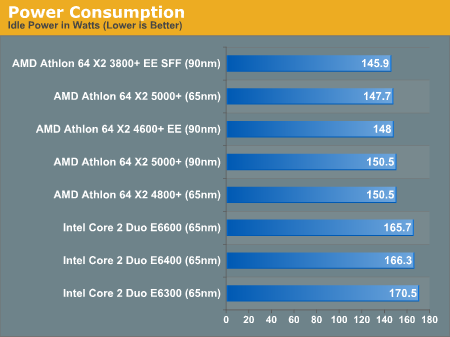AMD's 65nm Preview Part 2 - The Plot Thickens (Updated with Information from AMD)
by Anand Lal Shimpi on December 21, 2006 12:12 AM EST- Posted in
- CPUs
The Test
For each benchmark we measured performance as well as average power consumption during the course of the benchmark, finally reporting performance per watt as one divided by the other. Both Cool 'n Quiet and EIST were enabled on all processors.
| CPU: | Intel Core 2 Duo E6600 (2.40GHz/4MB) AMD Athlon 64 X2 5000+ (2.6GHz/512KBx2) AMD Athlon 64 X2 5000+ EE "Brisbane" AMD Athlon 64 X2 4800+ EE "Brisbane" AMD Athlon 64 X2 EE 4600+ (2.4GHz/512KBx2) AMD Athlon 64 X2 EE SFF 3800+ (2.0GHz/512KBx2) |
| Motherboard: | eVGA NVIDIA nForce 680i ASUS M2N32-SLI Deluxe |
| Chipset: | nForce 680i nForce 590 SLI |
| Chipset Drivers: | NVIDIA 9.53 NVIDIA 9.35 |
| Hard Disk: | Seagate 7200.9 300GB SATA |
| Memory: | Corsair XMS2 DDR2-800 4-4-4-12 (1GB x 2) |
| Video Card: | NVIDIA GeForce 8800 GTX |
| Video Drivers: | NVIDIA ForceWare 97.44 |
| Resolution: | 1600 x 1200 |
| OS: | Windows XP Professional SP2 |
Idle Power Consumption

Brisbane Performance Issues Demystified: Higher Latencies to Blame
Media Encoding Performance & Power Consumption










52 Comments
View All Comments
Spoelie - Thursday, December 21, 2006 - link
This is not the first time this has happened, it may be easy to forget, but do you guys remember the thoroughbred?Thoroughbred A was the first 180nm to 130nm shrink and had a hard time reaching the speeds the mature 180nm cores were getting. It wasn't till AMD added another layer to the core (Thoroughbred B) that we saw the expected speedups from a die shrink.
PetNorth - Thursday, December 21, 2006 - link
Anand:Why don't you set manually the voltage, to know really what's the improvement with 0.65 transition?
1.30v to compare it with 5000+ 90nm, and 1.25v to compare it with 4600+ EE 0.90nm.
It would be a good thing IMO.
yyrkoon - Thursday, December 21, 2006 - link
There are already people who believe that odd numbered multipliers offer worse performance compared to even numbered multipliers. I cant help but wonder why AMD chose to start implementing floating point multipliers now. The first thing that comes to mind, is maybe to refine their pricing ? Although, I've never really noticed much performance (if any) difference using odd vs even numbered multipliers, I can not help but wonder if floating point multipliers will play a factor in performance.Regs - Thursday, December 21, 2006 - link
AMD has been stepping in baby steps in their innovation merits. Ever since the IMC and the enhancements from K7 to K8 it seems like they improve little by little. I hope this gives them a rude awakening to how competitive the market can or could be in future. If they did it before they can do it again.As for the transition to 65nm, it was no surprise that these parts could not over clock very well. The K8 is showing its age and I think there are no more ways you can breathe life back into it especially when Core Duo is out in the market.
mino - Thursday, December 21, 2006 - link
Why awekening, and why rude? The fact is AMD kept PARITY with intel on power AND performance inthe lower end with 90nm!!! part with Intel beeing at 65nm for a year allredy!In other words, When AMD's 90nm process is FAR better that Intel's ever was. Same happened with 130nm. Two words: SOI,APM.
No confusion, all thi means no one should avaluate AMD vs. Intel on process_used base. Simply put, as of now(at stock) Intel rules on perf&power while AMD rules on idle_power and price(up to 4200+/E6300 combo).
IntelUser2000 - Thursday, December 21, 2006 - link
Intel bins Core 2 Duo by power consumption.
xsilver - Thursday, December 21, 2006 - link
just to clarify further; all e6600's will have lower stock voltages than e6400's and all e6400's will have lower stock voltages than e6300's?at both idle and load?
how successful are the conroes at undervolting?
Accord99 - Thursday, December 21, 2006 - link
Pretty good, my week 25 E6600 is stable at 2.6GHz/1.1v (My P5B-dlx doesn't go any lower) with dual-P95. The heat output is easily cooled passively by a Scythe Ninja.Here's a thread, one person has a E6600 that does 2.4@/~1v
http://www.xtremesystems.org/forums/showthread.php...">http://www.xtremesystems.org/forums/showthread.php...
blackbrrd - Thursday, December 21, 2006 - link
I have seen a E6600 running at 1,0v at load... It was obviously very cool running :)My E6400 is running at 1,15v at idle (2133MHz) and 1,25v at load (2133MHz)
Power saving features were off in both instances...
haugland - Thursday, December 21, 2006 - link
AMD win in one aspect...I you really consider power consumption to be important, it is much more important to look at idle power consumption than power consumption at full load. Most business PCs idle a lot of the time, and AMDs CPUs are much better at saving power at idle.
EIST was designed for P4, and for a 3+ GHz P4 it makes sense to drop the multiplier to 6. However when the E6300 normally run at a multiplier of 7, you don't get much of a power saving by dropping the multiplier to 6. AMD C'n'Q allows for much lower settings.